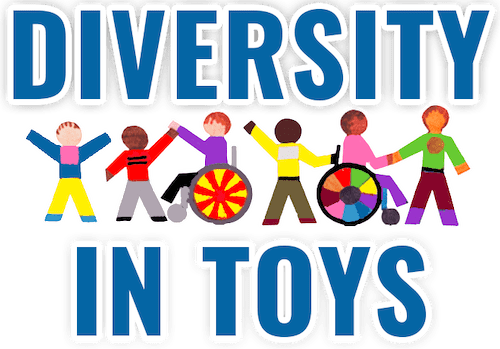How Positive Representation Improves Mental Health
Hooray — May is Mental Health Awareness Month! This month, we are running a series on how different types of toys can help improve children’s mental health outcomes. Today’s blog will examine one factor of mental health impact: positive representation in a child’s toys.
By positive representation, we mean toys, games, and books depicting people of all abilities, appearances, and backgrounds. Importantly, positive representation avoids stereotypes and aims for accuracy and individuality. We’ve previously written about how gendered toys can affect girls’ mental health. Here we’ll dive a little bit deeper into even more types of representation.
Below are some reasons why caretakers should strive to offer such representations to their children.
But first, why observe Mental Health Awareness Month?
Mental Health Awareness Month was first observed in the United States in 1949. Congress designated the month to recognize the number of veterans suffering from mental illnesses after World War II.
Now experts understand that mental health issues can affect folks of all backgrounds, experiences, and vocations. The month’s purpose now includes spreading awareness, fighting stigma, and providing support for a wide array of mental health issues. Throughout the month, organizations like Mental Health America and the National Institute of Mental Health share information and resources on caring for yourself and others with various mental health disorders.

Unfortunately, the rate of mental health challenges has increased substantially around the world in the last decade. It has particularly increased in children. A study last year by John Hopkins found that 21.8 percent of children in the U.S. aged 3 to 17 have one or more mental, emotional, and behavioral health conditions. The occurrence of these disorders coincide with factors like economic hardship, food insecurity, unsafe environments, racial discrimination, and Adverse Childhood Experiences (ACEs) like substance abuse or domestic violence.
The study ends on a hopeful note. Researchers suggest that positive interventions can offset the negative impact of these problems.

One such intervention is providing children with positive representations of folks who look like them. Interacting with positive representations of those different from them can also expand a child’s capacity for connection and understanding.
Building a child’s self esteem
Positive representation in a child’s toybox is important for two main reasons. First is the impact that positive representation has on a child themselves. Witnessing positive portrayals of folks that look or act like them increases a child’s self-esteem. Positive characters who share their physical attributes or cultural values help children see themselves as beautiful, capable, and worthy.
These representations additionally provide role models that children can emulate as they grow up. What children witness other people accomplishing directly influences their goals and dreams. When they see older versions of themselves achieving life goals, that child recieves the message that they, too, can reach those accomplishments.

Media and toys that feature characters that look like them also engage children more than things that do not. For example, children are motivated to read and participate in classroom discussions when their own experiences are reflected in the coursework.
Practicing empathy for others
The second major impact of positive representation is how it shapes children’s perceptions of those who are different from them. Seeing positive representation of folks who are different increases a child’s empathy and connection with others. For instance, recent research from Queen Margaret University in Edinburgh found that toys and resources depicting disability encourage children without a disability to make friends with disabled peers.

Offering children diverse toys can open conversations about differences among people and provide a learning point for your child. In a survey by Common Sense Media, 57% of parents reported that their child’s media consumption had prompted conversations about race and diversity. Even more agreed they want their children to watch and read about people with different cultures, religions, and races. Such exposure is crucial for preparing kids to live in a multicultural, multi-abled world.
What does positive representation look like?
Representation includes factors like race, ethnicity, disability, gender, age, class, or sexuality. Every person is made up of traits that incorporate each of those categories. Representation asks that people with a diverse range of traits are depicted in any given media or setting.

When experts talk about positive representation, they commonly mean two things. First, that the representation avoids stereotypes or attributing negative traits to all members of a group. Secondly, the representation depicts individual members of a community as just that: individuals. Key to providing good representation is exposing your child to a variety of characterizations of what any person can be. When your child looks into their toybox, do they see a world of possibilities for someone that looks or acts like them?

